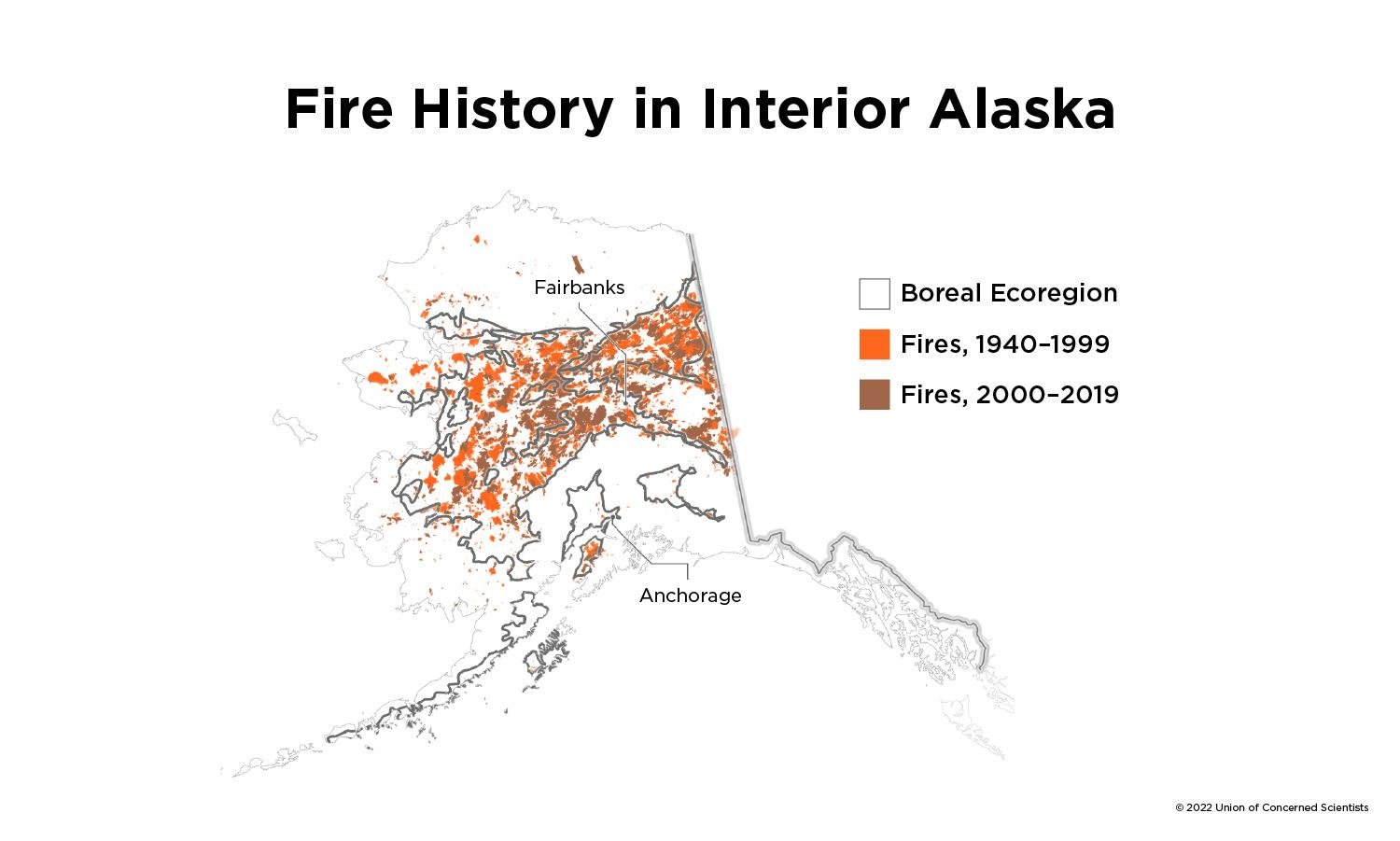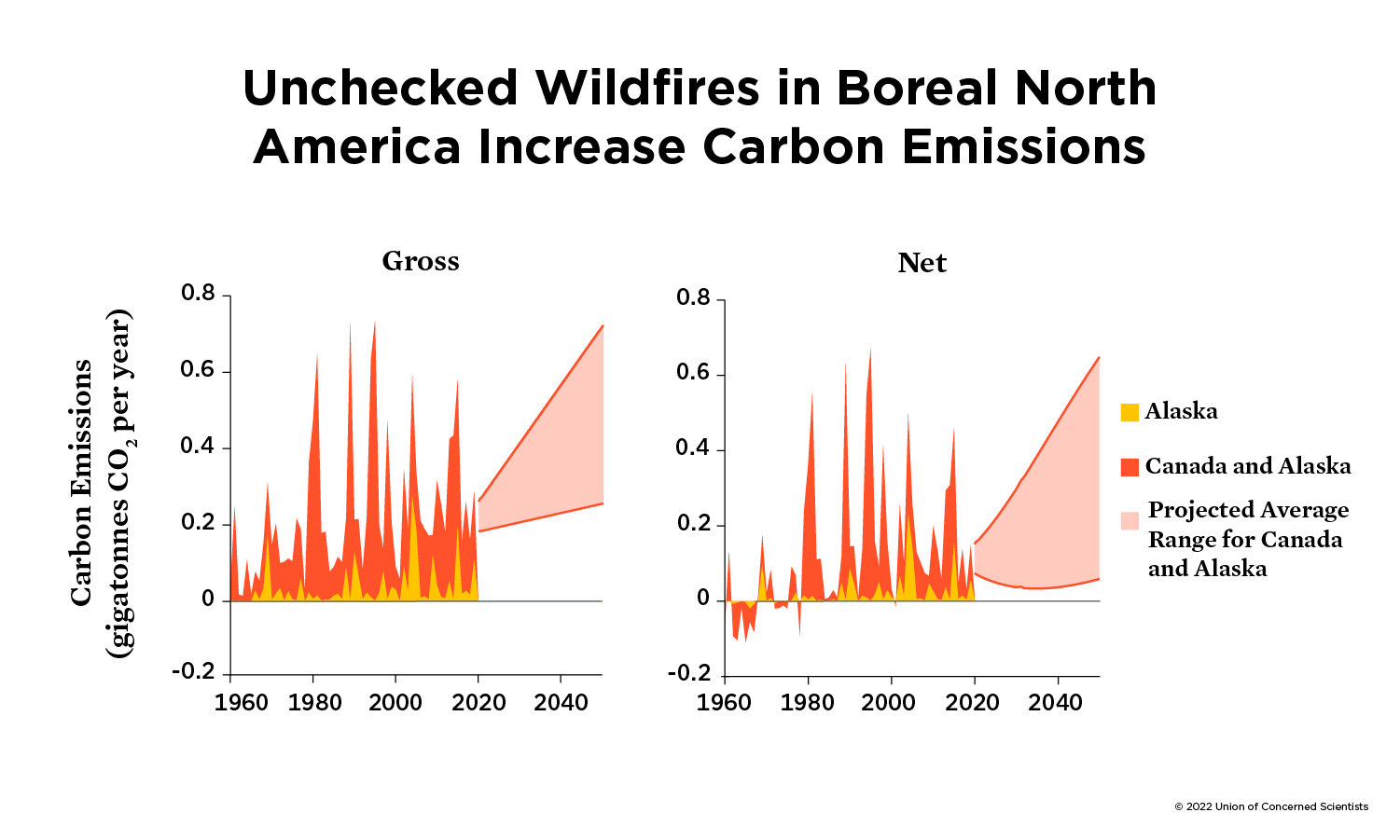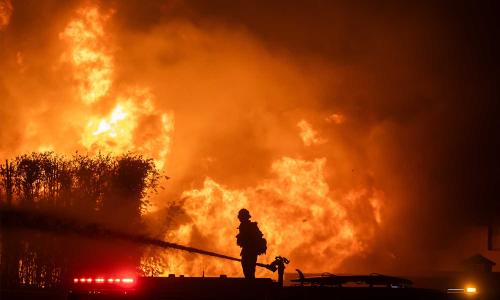Wildfires in the United States and Canadian boreal forests are projected to increase by as much as 169 and 150 percent, respectively, by 2050. They will have an outsized effect on climate change and the remaining carbon budget. Targeted fire management presents an opportunity to intervene and keep carbon out of the atmosphere.
Boreal forests store a huge amount of carbon—about two-thirds of what all forests store combined—so it’s imperative that fires, which release this carbon into the atmosphere, are minimized in these regions.
Fires that occur in US and Canadian boreal forests between now and 2050 could release up to about 3 percent of the remaining global carbon budget—equivalent to the annual emissions of 2.6 billion cars—unless greater investments are made to limit fires in these carbon-rich forests.
The study found that:
- We need to manage boreal forest fires differently—not only to protect people’s lives and property, but also to address climate change, which means investing more in boreal forest fire suppression.
- Fire management in boreal forests is a cost-effective way to reduce emissions, averaging about $12 to avoid 1 ton of carbon emissions.
- The United States should invest an average of $696 million a year over the next decade to keep Alaska’s forest fires and their carbon emissions in check.
Limiting Carbon Emissions from Wildfires in North America’s Boreal Forests
This is an online version of the executive summary. For all figures and the full text, download the PDF
Boreal forests, the largest land biome on Earth, occupy more than 6 million square miles, more than twice the land area of Australia (Figure 1). Coniferous species such as spruce and pine, as well as deciduous species including larch and birch, thrive in these ecosystems. Bogs and wetlands interspersed within forested stands create a rich mosaic of habitat on the landscape. Boreal zones are home to iconic animal species, including salmon, grizzly bears, wolves, and moose, as well as iconic locations, such as Alaska’s Denali National Park.
Boreal forests also contain huge amounts of carbon. Although they represent a third of global forested area, boreal forests contain roughly two-thirds of global forest carbon (Bradshaw and Warkentin 2015, Pan et al 2015). In contrast to other types of forest, most carbon in the boreal biome is stored belowground, as seasonally thawed organic soil and permafrost, or permanently frozen ground. Permafrost can be “continuous”—frozen year-round—or “discontinuous,” interspersing patches of permafrost with non-permafrost (yet still carbon-rich) soil.
Historically, boreal forests across North America—where fire is a naturally occurring phenomenon—have experienced relatively infrequent but high-intensity fires that kill large areas of vegetation and restart the process of forest succession (Rogers et al. 2015). These ecosystems have a different relationship with fire than those in the continental United States, which historically experienced frequent but low-intensity fires.
Due to their high latitude, boreal forests are warming twice as fast as other ecosystems, leading to a pronounced increase in burned area over the past 50 years (Figure 2). Rising temperatures increase the risk of fires and facilitate their spread by priming ecosystems to burn. Snowmelt happens sooner, allowing more time for trees, soils, and dead vegetation to dry out. Lightning strikes, which ignite some of the largest fires in these ecosystems, occur more often, and high winds, low humidity, and other conditions that facilitate the spread of fire are more likely to occur in extreme conditions.

The boreal region of North America, spanning the United States and Canada. Forest cover denotes forested land as of 2000, the most recent year for which data are available.
Global Carbon Emissions: The Consequences of Unchecked Burning
As of January 1, 2018, the United Nation’s Intergovernmental Panel on Climate Change has quantified the specific ceiling of remaining carbon dioxide (CO2) humans can emit while still maintaining the increase of global average temperatures to less than 1.5–2°C above preindustrial levels—roughly 400 gigatonnes (IPCC 2021). Our research suggests that emissions from boreal forest fires in North America might increase by roughly 30 to 160 percent by midcentury. Left unchecked, fires in this region could release nearly 12 gigatonnes of CO2 during that time (Figure 3). That’s nearly 3 percent of the remaining allowable emissions if the world is to keep global temperature increase to 1.5°C (see methodology box).
These numbers alone are cause for alarm and intervention, yet they likely underestimate the total carbon loss associated with wildfires, which modify ecosystem processes affecting carbon dynamics. For example, boreal wildfires accelerate permafrost thaw and degradation, exposing anciently stored carbon in vegetation and soil to decomposition. By some estimates, emissions from post-fire decomposition are more than four times those from fire (Genet et al. 2013). Further, our analysis also did not include emissions of other, more potent heat-trapping gases emitted from fires such as CH4 and N2O, which can double the climate impact. In contrast, projected shifts from spruce-dominated forests to less-flammable deciduous species, such as birch and aspen, may reduce the likelihood of future burns. However, such transitions may exacerbate permafrost thaw, and as a result, send more CO2 into the atmosphere.
Beyond the feedbacks related to climate change, increasingly large and severe boreal wildfires threaten the livelihoods and health of communities across boreal North America. During wildfire season, high concentrations of smoke and particulate matter can both reduce local air quality to hazardous levels and also travel as far as Europe and the east coast of the United States. Further, rampant boreal wildfires can disrupt subsistence activities such as hunting, threatening both climate mitigation efforts and human health.

In the 60 years between 1940-1999, an average of 568,520 acres of boreal forests burned each year. In contrast, in the 19 years between 2000-2018, an average of 1.4 million acres burned each year.
Boreal Fire Management as a Climate Mitigation Strategy
To facilitate and prioritize rapid decisionmaking around suppressing fires, all land across Alaska is grouped into four distinct management zones. Fires in the Critical Zone, often near population centers or other values at risk, are fought most aggressively. On the opposite end of the spectrum, fires in the Limited Zone are mostly monitored and allowed to burn. Full and Modified zones receive intermediate suppression efforts.
These designations integrate several values at risk in any given area, including human life, structures, and wildlife, and they streamline the decisionmaking process across government agencies, Alaskan Native communities, and others who own and manage land. Although these zones cannot capture every factor that goes into decisions, they serve as a proxy for suppression and help to quantify the impact of those efforts. Notably, risks associated with carbon emissions are not part of priority-setting considerations for managing fires in Alaska or other boreal forest regions.
Using data from more than 3,000 fires that burned across Alaska’s boreal zone from 2000 to 2018, our research shows that Alaska’s existing fire-management plan invests the greatest suppression effort in fires that are, on average, smaller in area. This suggests that fire suppression in Alaska, as currently executed, effectively limits fire size and, therefore, could be operationalized to limit emissions.
We also examined the economics of fire management, namely the relationship between spending and fire size, as well as the cost of averting boreal wildfire emissions (in US dollars per ton of CO2). That enabled us to compare fire suppression in boreal forests to other emissions-reduction strategies. Within the United States, Alaska receives disproportionately few federal resources for fire management—an average of less than 4 percent of resources each year despite accounting for roughly 20 percent of US land area and half of average annual US fire emissions. Since fire management does not consider carbon and climate mitigation, these resources are allocated to protect human lives and then assets/property. Our analysis of data on suppression spending suggests that increasing spending in Alaska’s boreal forests by 1 percent would reduce fire size by 0.21 percent on average; thus, increasing resources for fire suppression in Alaska could decrease burned area and emissions, while moderating the negative impacts of smoke and particulate matter.
Our results also indicate that fire management in Alaskan boreal forests costs relatively little (~$12.63 to avert a ton of CO2) compared with other well-known strategies for reducing emissions, such as on-shore wind power (~$23–$26 per ton) and utility-scale solar (~$32–$41 per ton) (Gillingham and Stock 2018). Further, we find that reducing emissions to historic levels in Alaska would require an average investment of roughly $696 million annually, roughly four times the annual average on Alaskan fires (~$120 million), or about $6.96 billion over the next 10 years. This investment would not only reduce carbon emissions but also improve air quality and limit disruptions to Alaskan communities.

Conclusion
Escalating carbon emissions from boreal forest fires threaten our global ability to reach net-zero emissions by 2050. As temperatures rise, fires across boreal North America burn larger and larger areas, in the process emitting huge quantities of carbon and decreasing air quality in downwind communities. However, management strategies present opportunities to reduce emissions from these forests and improve air quality for communities that experience the negative effects of these fires. Given the complexity of fighting large fires in extreme weather, our research highlights the potential role of increased resources and options for initial attack on ignited boreal fires. Further, by allocating more resources for Alaskan fire management, which are currently far less than Alaska’s proportion of burned acreage and wildfire emissions relative to national spending, the United States can decrease burned area and reduce carbon emissions.
Taken together, the UCS/Woodwell-led research indicates that increased spending could reduce fire size by expanding fire-suppression efforts. While limiting boreal wildfires has not been explicitly considered as a climate mitigation strategy, our results suggest that increased investments in managing boreal fires could cost-effectively reduce emissions and yield significant collateral benefits. In the context of a portfolio of climate mitigation strategies that include dramatic reductions in fossil fuel emissions, enhanced boreal fire management could play an important, previously overlooked supporting role toward bringing emissions to net-zero by mid-century and limiting global temperature rise to 1.5°C.
Carly A. Phillips is a former UCS Kendall fellow for protecting carbon in Alaska’s boreal forests; she is now a researcher-in- residence at the Pacific Institute for Climate Solutions at the University of Victoria in British Columbia. Brendan M. Rogers is an associate scientist at Woodwell Climate Research Center. Molly Fletcher is a fourth-year PhD candidate at the Fletcher School of Law and Diplomacy at Tufts University. Peter C. Frumhoff was the director for science and policy and chief climate scientist at Union of Concerned Scientists through 2021. He is currently a visiting scientist at the Harvard University Center for the Environment.
This is an online version of the executive summary. For all figures and the full text, download the PDF
Downloads
Citation
Phillips, C.A., Rogers, B.M., Elder, and Frumhoff, P.C. 2022. Limiting Carbon Emissions from Wildfires in North America’s Boreal Forests: Fire Management as a Carbon Mitigation Strategy. Cambridge, MA: Union of Concerned Scientists. https://ucsusa.org/resources/carbon-emissions-boreal-forest-wildfires
Phillips, C.A., Rogers, B.M., Elder, M., Cooperdock, S., Moubarak, M., Randerson, J.T., and Frumhoff, P.C. 2022. Escalating carbon emission from North American boreal forest wildfires and the climate mitigation potential of boreal fire management. Science Advances. DOI:10.1126/sciadv.abl7161








